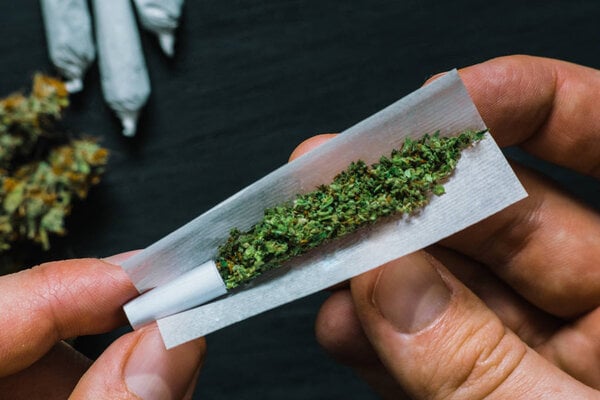
How much THC in a joint?
How much THC is in a joint?
How much THC is in a typical joint?
A common question smokers ask about their joints is, “How many milligrams of THC are in a joint?”
The answer is not as simple as you would like. First we need to gather some additional information.
How much weed is in a joint?
After reviewing online pharmacies, the most common pre-rolls found for sale in pharmacies are 0.5g and 1g.
But according toResearch using federal drug arrest data(from 2000 to 2010), published in the journal Drug and Alcohol Dependence in 2016. The average amount of weed in a joint was estimated to be just 0.32 grams.
This data predates the widespread legalization of cannabis in the United States. Since then, the average joint size may have increased along with the market and consumption of marijuana in the United States. However, in this article we will use the 0.32 grams from the study as a baseline value.
How much THC is in marijuana?
Different parts of the plant have different THC concentrations. The stems and leaves contain less THC than the bud itself. Let's say we only use buds with a standard strength. Then you can calculate the total milligrams of THC in a joint.
The THC content in weed can vary greatly depending on the cannabis strain. THC-dominant strains can have a THC content of around 8% to 30% by dry weight. You may occasionally find strains with higher THC levels. The biological limits of THC production mean that the THC dry weight content is around 25%.
On average, higher THC strains contain around 15 to 20% and the “very potent” strains contain around 25%.
Fortunately, all reputable stores in the US carry lab-tested cannabis, so the THC content is listed on the packaging.
If you don't mind a little math, you can easily calculate the THC content in your joint using the THC percentage listed on the packaging.
Calculating the total THC in a joint
Testing labs use a simple mathematical expression to calculate the theoretical maximum amount of THC in cannabis.
THC max = THC + THCA / 358.48 * 314.47
This expression gives the laboratory an estimated amount of THC in a sample. You will likely find this cost estimate on the packaging of weed you purchase from legal dispensaries.
Let’s say you have a joint containing 1 ounce of lemon sour diesel with 18% THC.
Let's convert this 0.32 grams into 320 milligrams. Since the stretch is 18 percent, we multiply 0.18 by 320.
0.18×320 = 57.6 milligrams of THC
Even if we know the potency of the cannabis strain and calculate the maximum amount of THC in a joint, that is not the amount you will consume during your smoking session.
How much THC will I consume when smoking a joint?
There are four factors that determine how many milligrams of THC you can consume when smoking a joint. These are potency, joint size, bioavailability and the physiology of the smoker.
This is where things get a little complicated. There can be a noticeable difference in how much THC is in your weed and how much THC you consume.
Our Lemon Sour Diesel Joint with 57.6 mg THC does not mean you would take the entire 57.6 mg.
This difference between potential THC and THC available for consumption is due to the availability of THCA (THC in its non-psychotropic form) in an unlit joint. Some of it is lost when we burn the cannabis. it will literally go up in smoke.
When ignited, the THCA is converted into THC. This is called decarboxylation and describes the removal of carboxyl from THC acid.
The temperature and time required for decarboxylation determine the total amount of THC you can consume in a joint.
Approximately 40% of THC is lost when smoking a joint. This means we could get 0.6 x 57.6 mg, or a maximum of 34.56 mg THC.
Smoking weed from a bong bowl or hand pipe creates less waste because the weed burns off and the smoke is not consumed. A vaporizer creates even less waste because it doesn't burn, so no THC is lost in the combustion/heating process.
How does bioavailability affect THC consumption?
It would be impossible to consume the entire amount of THC in one joint. Bioavailability, i.e. the amount of a cannabinoid that enters the systemic circulation after consumption, also plays a major role.
The bioavailability of inhaled THC is between 10 and 35%.
So even if we use the best value of 35%, you would consume around 12 mg of THC from the 0.32 gram serving of Citric Acid Diesel. This also assumes that you inhale every bit of smoke from the joint, which is unlikely even when hotboxing.
How a smoker's physiology affects THC consumption
Every person's body chemistry is different. Age, health, diet and many other factors play a role. This means that there is no uniform way the body breaks down or tolerates THC.
How your body absorbs and processes THC is determined by several factors, such as lung capacity and the amount of THC exhaled in the smoke. Contrary to popular belief, holding the smoke in the lungs for more than a few seconds does not increase THC absorption. However, taking deep, full breaths when inhaling allows more smoke to enter your lungs and helps improve THC absorption when smoking a joint.
Additionally, you should keep in mind that people who are not used to smoking react differently to THC than regular or regular users.
The more you consume cannabis, the higher your tolerance becomes; the more THC your body can handle. Additionally, consumers respond differently to THC, regardless of the strength of the strain.
If you don't have the patience to do these calculations, blood tests are an easier, albeit more expensive, way to determine exactly how much THC you've consumed. This is the only way to know for sure.

Post a comment: